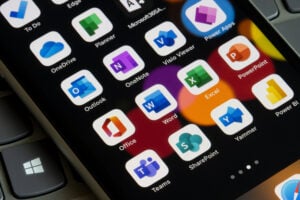New(er) Collaboration Tools in MS Outlook/365
 If you are a Microsoft 365 Business Standard or Premium subscriber and using the Exchange and SharePoint server products that are bundled with the offer, you may have some new collaboration tools to explore. While these are very new, additions like reactions, @mentions, Loop, and notifications may help you stay on top of email as an action item in a different way.
If you are a Microsoft 365 Business Standard or Premium subscriber and using the Exchange and SharePoint server products that are bundled with the offer, you may have some new collaboration tools to explore. While these are very new, additions like reactions, @mentions, Loop, and notifications may help you stay on top of email as an action item in a different way.
Loop Components
Microsoft has been talking about Loop (you can sign up to be first to get notifications here) for quite a while. Loop is a way to collaborate within the MS 365 ecosystem that is independent of the application so that you can add Loop components to email, to a Word document, or to a Teams chat. Eventually Microsoft plans to roll out Loop pages and Loop workspaces, described by TechTarget as a “next generation OneNote”.
Loop components allow you to collaborate on text that is not tied to a specific application or document. You can add a Loop component to a document and then link to it in an email and the recipient can review or make a change to the Loop in the email and the document will update. Or add a Loop component to a Teams chat to knock out some language without having to go into a specific document. Another benefit of Loop components is if they are used across the Microsoft applications documents with embedded Loops will be up to date if the Loop is altered – no matter where the document “lives”.
While Microsoft is still rolling out Loop, competing product Notion has become the darling application of collaboration during and after the pandemic. Real time collaboration of this kind allows hybrid and remote workforces to collaborate on elements that involve them, without having to navigate through file and folder structures to find relevant text in documents and emails.
In Microsoft Outlook if you are using the MS 365 business subscriptions with the included hosted Exchange and SharePoint you may see (or soon see) a new Group in the Message tab of the Ribbon called “Collaborate” that includes Loop Components. You can drop in bulleted or numbered lists, Q/A, tasks, a table or a paragraph. Send it via email and the recipient can edit the Component and respond.
Like OneDrive sharing, you can control whether the recipient can view or edit by clicking on the Component name and then “Manage Access”. The default setting is view only so if you want to collaborate you will need to change access rights to “can edit”. Currently you cannot share a Loop component outside of your Microsoft tenant, so this will not work with clients or those outside of the firm or office.
In the text you can add headings and make some minor formatting choices (bold, italics, underline). Like real time collaboration on a Word document, if you open an email that has a Loop component and someone you shared it with is editing you can see their avatar. You can also identify the last person to edit the component. Finally, you can create a link to the component to share elsewhere.
In MS Teams chat you can also add a Loop component. If you want to see all your Loop components in one place, simply head over to MS OneDrive and look in the Attachments folder or the “Shared By You” folder. Or in SharePoint look in My Files. The Loop components are automatically stored.
@mentions and Notifications
In Microsoft 356 you can mention a work colleague in MS Outlook, in Word comments, and in Teams chat. Simply type @ and the person’s name and they will receive a notification that you have mentioned them. For instance, if you mention someone in an email with the @name in the body text it will add them to the “to” line, highlight their name in the message, and they’ll see the @ symbol next to the message in their Inbox. plus get a notification.
In Microsoft Outlook, the bell symbol in the upper right corner now shows @mentions, notifications of Loop components aand comments/changes to shared documents, and reactions.
Reactions
Do you want to acknowledge receipt of an email like you would a text message? When you open an email you receive in MS Outlook you will see a toolbar to the left of the header. Click on the smiley face and you have a variety of emojis you can use to react to the email without typing a word. You will get a notification, see the reaction in the email, and if you react to someone’s email, they will receive a daily digest (if they are also MS Outlook users).
Conclusion
Microsoft is always adding new tools and elements to the MS 365 suite. Some are useful, some are not yet ready for prime time, and some are just fun. If you want to keep up with what is going on with Microsoft tools you can go to the Microsoft 365 blog, subscribe to an Office Watch newsletter, or subscribe to the NCBA CPM ICMI newsletter.